Presentation of gallbladder torsion at an abnormal position:A case report
2020-09-15
Jia-Sui Chai,Xu Wang,Xiao-Zheng Li,Peng Yao,Hong-Jie Zhang,Jia-Yong Ning,Yan-Bing Cao,Department of Hepatobiliary Surgery,Yuncheng Central Hospital,the Eighth Clinical College of Shanxi Medical University,Yuncheng 044031,Shanxi Province,China
Zheng-Zheng Yan,Department of General Surgery,Shanxi Bethune Hospital,Shanxi Academy of Medical Sciences,Taiyuan 030032,Shanxi Province,China
Abstract
Key words:Gallbladder torsion;Laparoscopic cholecystectomy;Magnetic resonance cholangiopancreatography;Ultrasonography;Computed tomography
INTRODUCTION
Gallbladder torsion is a rare acute surgical a bdominal condition,with>500 cases published since it was first reported as floating gallbladder by Wendell in 1898[1-3].Only 483 articles were obtained when PubMed was searched using the terms“(gallbladder torsion) or gallbladder volvulus”.Gallbladder torsion is defined as the rotation of the gallbladder along the axis of the cystic duct,on its pedicle or any location between the neck and fundus[2,4,5].The symptoms of incomplete torsion are usually similar to biliary colic,and with complete torsion,there will be a suddenonset of severe upper abdominal pain and associated vomiting[4].It is a challenge for radiologists and surgeons to diagnose the condition preoperatively,despite the availability of advanced imaging and laboratory techniques,and most cases are diagnosed during surgery.Prompt surgery decreases the mortality and morbidity of perforation due to gallbladder torsion[6].
Here,we present a case of an abnormally swollen gallbladder twisted in the lower abdomen,which was successfully treated with urgent laparoscopic cholecystectomy,as well as a literature review of gallbladder torsion.
CASE PRESENTATION
Chief complaints
An 82-year-old woman presented to our emergency department with persistent pain in the upper-right quadrant of the abdomen.
History of present illness
The patient reported pain of 6 days duration,with associated nausea and vomiting,without any referred pain.She also complained of chills and her temperature was 38.5°C.There was no jaundice in the skin and sclera.
History of past illness
The patient had a history of hypertension for 10 years,pulmonary embolism 3 years ago and hysterectomy 27 years previously.
Personal and family history
There was no personal history of tobacco or alcohol consumption,nor any noteworthy family medical history.
Physical examination
Height and weight of the patient were 155 cm and 42 kg,respectively.Physical examination revealed a longitudinal scar of 10 cm in the lower abdomen,and a fistsized mass around the umbilicus that was tough,with clear boundaries,poor mobility and obvious tenderness (Figure1).There were no positive signs in other areas of the abdomen,or a positive Murphy sign.
Laboratory examinations
Laboratory data indicated that her leukocyte count was slightly elevated,C-reactive protein and procalcitonin level were 113.8 mg/L and 0.23 ng/mL,respectively,and liver function tests and pancreatic enzyme concentrations were within normal limits.

Figure1 Physical examination showing a mass in the region around the umbilicus.
Imaging examinations
Ultrasonography (US) and computed tomography (CT) showed a cystic mass in the lower abdomen and upper pelvis with multiple nodules of high-density calcifications(Figures 2 and 3),suggesting an abnormally positioned gallbladder with multiple stones and thickening wall,multiple cysts in the liver and kidney,and a small amount fluid in the pelvis.There were no portal vein abnormalities or hepatic deformity.Magnetic resonance imaging (MRI) also demonstrated a cystic mass in the middle of the abdomen with multiple low-intensity T2-weighted signals and edema of the adjacent abdominal wall,suggesting an ectopic enlarged gallbladder with multiple stones and inflammatory changes.Magnetic resonance cholangiopancreatography(MRCP) showed a V-shaped distortion of the extrahepatic bile ducts and a particularly extended twisted cystic duct (Figure4).
FINAL DIAGNOSIS
The final diagnosis of this emergency abdominal condition was gallbladder torsion.
TREATMENT
The results indicated an abnormally enlarged ectopic gallbladder with disordered extrahepatic bile ducts,and a diagnosis of gallbladder torsion was considered,which is an indication for emergency surgery.The preoperative evaluation showed spinal deformities (Figure5),without any contraindications for surgery.Laparoscopic cholecystectomy (LC) was subsequently performed and the surgical investigation indicated that the swollen necrotic gallbladder was twisted approximately 360 degrees in a counterclockwise direction,not adhered to the liver but to the adjacent abdominal wall,with cystic duct and arterial rotation.Torsion of the gallbladder in the middle of the abdomen could not be corrected.Following ligation and severing of the cystic artery and duct,the gallbladder was disconnected from the hepatic hilum.A 3 cm incision was then made to decompress and remove the gallbladder (Figure6).
Pathological findings
Histopathologic findings of the specimen showed acute gangrenous cholecystitis(Figure7).
OUTCOME AND FOLLOW-UP
The patient recovered well and was discharged within 5 d,with a good prognosis after 3 mo of follow-up.

Figure2 Ultrasonography showing a cystic mass in the lower abdomen and upper pelvis with multiple highly echoic nodules.
DISCUSSION
Gallbladder torsion is a rare condition and has been reported in all age groups;however,it occurs more commonly in elderly people[7-9],with an incidence of 1 in 365 520 hospital admissions[10].The incidence increases with age,peaking at 60-80 years[7,11].The occurrence is higher in women than in men in the adult population,with a ratio of 4:1,which contrasts with a ratio of 1:3 between girls and boys[7,12].This phenomenon is commonly associated with anatomical variants of the vascular pedicle to the gallbladder and the abnormally elongated mesentery of the gallbladder-toliver[12].A decrease in visceral fat is considered to be associated with a higher incidence in the older age group,which explains why it presents in people who are in good health for decades despite a congenitally floating gallbladder[13].Other contributing factors include peristaltic activity of the stomach,duodenum and surrounding colon,presence of spinal deformity,and even a tortuous atherosclerotic artery of the cyst[4].The presence of gallstones are considered incidental with a rate of 24.4%-32%,while cholelithiasis has been identified as a major culprit in most gallbladder diseases[3,7,14].Several risk factors associated with gallbladder torsion are age>70 years,female sex,weight loss,liver atrophy,scoliosis,atherosclerosis,elongated mesentery,and loss of visceral fat[6].
Gallbladder torsion can be classified into two types.Type I:Incomplete,with gallbladder rotation < 180 degrees,with a long and wide mesentery supporting the gallbladder and cystic duct;and type II:Complete,when gallbladder rotation is>180 degrees with incomplete mesentery supporting only the cystic duct[4,12,15].During pathogenesis,the gallbladder can rotate in a clockwise or counterclockwise direction,and no significant relationship was found between the direction and the degree of torsion[7].Patients usually present to the emergency department with a history of mild to severe right upper quadrant pain and associated nausea or vomiting,and most without associated signs of jaundice or toxemia[4,16].A palpable mass due to the swollen gallbladder is present in some patients,with obvious tenderness[17].Patients with incomplete torsion are often misdiagnosed with biliary colic due to non-specific symptoms and signs,whereas complete torsion usually results in compromised blood supply with sudden onset of severe abdominal pain,infarction and gangrene of the gallbladder,which can be fatal[4,12].The present case,in which the gallbladder rotated 360 degrees was type II and pathological examination verified acute gangrenous cholecystitis.
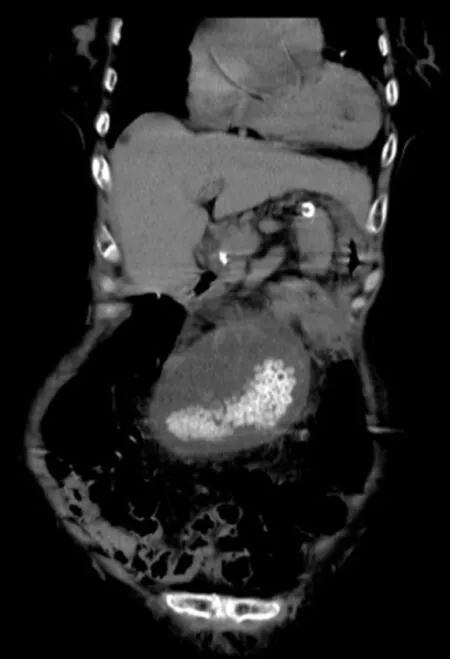
Figure3 Computed tomography showing a cystic mass in the lower abdomen and upper pelvis with multiple nodules of high-density calcifications.
US and CT findings are generally nonspecific but usually show a floating gallbladder with wall thickening[4].Enhanced CT and MRI often indicate a reduction in blood flow to the gallbladder,V-shaped distortion of the extrahepatic bile ducts due to cystic duct traction,and even a cystic duct knot sign[18].Absence of blood flow can also be seen on Doppler US[13].The specific finding of gallbladder torsion in CT images with a “whirl sign” showing the twisted pedicle of the cystic duct and mesentery is not always present[19].MRI can indicate hemorrhagic infarction and necrosis of the gallbladder with a high-intensity area within the cystic wall on T1-weighted images[18].In our case,US and CT images showed an abnormally enlarged gallbladder with multiple stones and thickened wall in the lower abdomen,as well as an elongated mesentery from the hepatic hilum.MRCP showed a V-shaped distortion of the extrahepatic bile ducts and a particularly extended cystic duct,which was twisted and could be called “twisting signs” (Figure4).To date,there are few reported cases that show the twisting signs clearly.Spinal deformities in our case may have contributed to the pathological appearance.Accumulated typical features of gallbladder torsion have been reported,appearing on US,CT and MRI[18].However,the preoperative diagnosis of this condition was achieved in only 26% of patients because of its rarity[7].It is usually diagnosed as acute cholecystitis requiring emergency surgical intervention,although it is difficult to assess the condition exactly[18].Mortality and morbidity of the cystic perforation are decreased with prompt laparotomy after identification of the indication for surgery[16].Surgery can be performedviaopen or laparoscopic approaches.A study showed that gallbladder torsion accounted for 1.5% of patients who underwent urgent LC for acute gallbladder disease,and suggested that emergency LC is feasible for this rare acute abdominal condition[20].The critical steps are decompression and derotation of the gallbladder to obtain a clear view of the extrahepatic bile ducts.Sometimes it is difficult to perform detailed inspection of the anatomical structures with laparoscopy due to the abnormal position of the biliary tract.Timely conversion to open surgery during LC can avoid iatrogenic bile duct injury.
CONCLUSION
Gallbladder torsion is an acute surgical condition that is often misdiagnosed,which might result in significant mortality and morbidity due to cystic perforation without prompt laparotomy.Older patients with nonresolving symptoms of acute cholecystitis should be investigated for possible gallbladder torsion.A displaced floating gallbladder seen on US and CT,as well as elongated mesentery,may suggest gallbladder torsion.Specific signs such as V-shaped distortion of the extrahepatic bile ducts,whirl sign or twisting signs on CT or MRCP can indicate the diagnosis.The outcome for this pathological condition is excellent after emergency cholecystectomy.
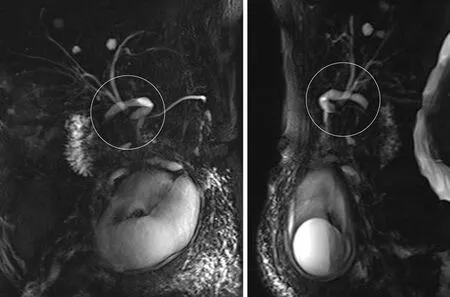
Figure4 Magnetic resonance cholangiopancreatography showing a V-shaped distortion of the extrahepatic bile ducts and a particularly extended twisted cystic duct,called “twisting signs”.
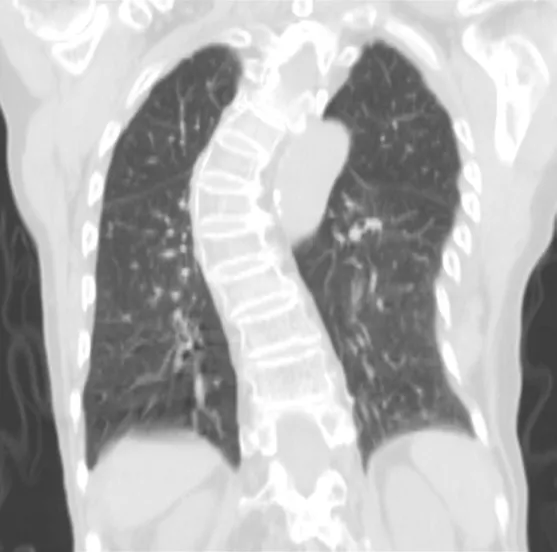
Figure5 Chest computed tomography before surgery showing spinal deformities.
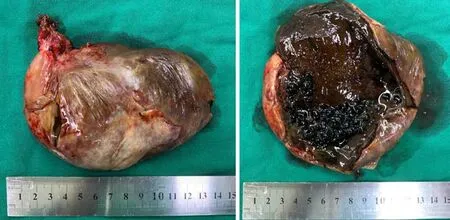
Figure6 Decompressed gallbladder.
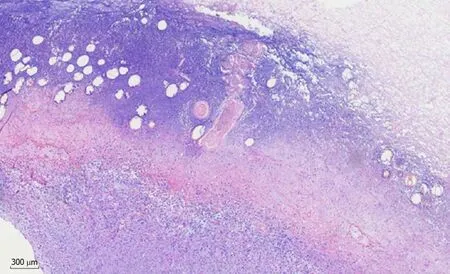
Figure7 Histopathological findings showing acute gangrenous cholecystitis.
杂志排行
World Journal of Clinical Cases的其它文章
- Assessment of diaphragmatic function by ultrasonography:Current approach and perspectives
- Computer navigation-assisted minimally invasive percutaneous screw placement for pelvic fractures
- Research on diagnosis-related group grouping of inpatient medical expenditure in colorectal cancer patients based on a decision tree model
- Evaluation of internal and shell stiffness in the differential diagnosis of breast non-mass lesions by shear wave elastography
- Real-time three-dimensional echocardiography predicts cardiotoxicity induced by postoperative chemotherapy in breast cancer patients
- Lenvatinib for large hepatocellular carcinomas with portal trunk invasion:Two case reports
